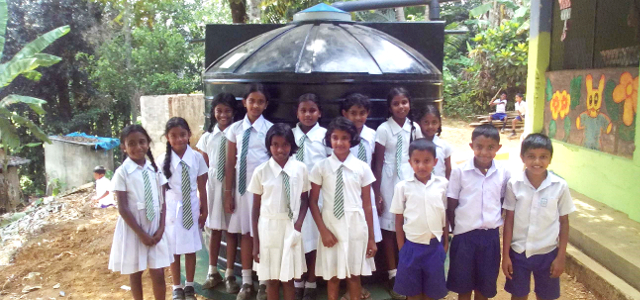Description
Aranayake, a significant part of Ma Oya upper catchment is severely, continuously and increasingly water stressed. Following the Samasara landslide, communities in Aranayake noted several significant changes in the hydrological regime.
Of the 62 Grama Niladhari divisions in Aranayake – an administrative division used at a rural level in Sri Lanka - 60 were classified as disaster prone. The fear of landslides has not left the sub-conscious of Aranayake’s citizens. In late October 2017, heavy rains brought with them two more minor landslides in Ambalakanda and Aranayake leading to the immediate evacuation of at-risk families by local administrators.
Action taken
The Maha Oya Mithuro: Friends of the Maha Oya is the oldest Area Water Partnership (AWP) in Sri Lanka established in 2001. Through the AWP, GWP Sri Lanka (also called Lanka Jalani) has played a catalytic role in bringing stakeholders together to foster productive management of water resources in the area and have been involved in tackling the issues of illegal sand mining and other community development activities for nearly two decades.
To implement the Disaster Risk Reduction (DRR) activity outlined in this case, Hatton National Bank (HNB) entered into an agreement with GWP Sri Lanka in January 2017 with the following objectives:
- Improving school sanitation, renovation of school sanitation facilities and supplying RWH tanks and associated activities for 10 selected schools across Aranayake to improve levels of hygiene and community well-being.
- Enhancing awareness and carrying out sanitation sensitization of school-related stakeholders in targeted communities.
- Improving access to education for improving health and leading to better living.
10 schools with 2,214 students and 168 staff members were provided with Rain Water Harvesting (RWH) tanks and trained on how to operate and maintain these structures to raise water security of the region.
Lessons learned
This intervention was timely and addressed a real issue impacting the lives of communities in Sri Lanka’s Central Province. The complexity of this disaster has highlighted the need for speedily operationalizing the SDGs in future activities and moving away from disaster relief to disaster risk reduction.
- There was consensus that unless immediate measures are taken to improve soil conservation in relation to tea smallholdings and reforestation is done in the catchment, there is a strong possibility of another landslide.
- Engaging with the community helped identify the most important form of Disaster Risk Reduction – a model that involves and is supported by local.
- In a scenario where DRR is of critical importance, schoolchildren can be the most important conduit of DRR information. A child who does not encounter value in his or her own environment cannot be expected to protect it. A non-supportive environment for ecosystem protection is caused by a school system, which does little to foster encounters with ground conditions.
- Schools that received RWH tanks are expected to use this for maintenance of school attendance especially for girl children. Menstrual Hygiene Management (MHM) calls for properly maintained, preferably girl friendly toilets. This is very important to maintain girls’ education as studies have shown that poor sanitation leads to absenteeism of 3-5 days for girls in many schools. With access to water through RWH, it may be possible to increase the debate to MHM as well.

